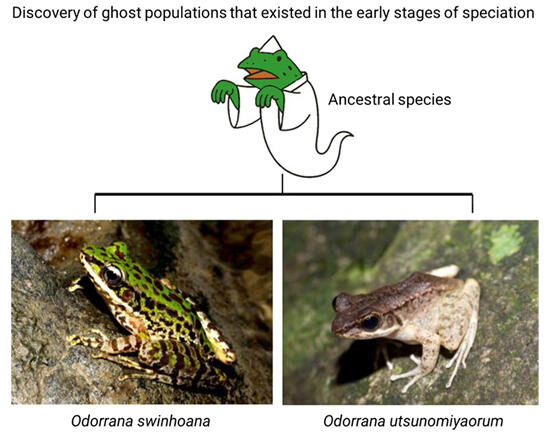A research group including Researcher Ikuo Miura from the Amphibian Research Center at Hiroshima University, Associate Professor Mamoru Toda from the Tropical Biosphere Research Center at the University of the Ryukyus, Project Researcher Hung Ngoc Nguyen from the Graduate School of Frontier Sciences at the University of Tokyo, and Professor Si-Min Lin from National Taiwan Normal University has announced the discovery of an ancient ancestral population that is the common origin of the Odorrana swinhoana inhabiting Taiwan and its closely related species, the Odorrana utsunomiyaorum living in the Yaeyama Islands of Japan. This is an example of "ghost introgression" with traces left only in the mitochondrial genome through hybridization, revealing the difficulty of an evolutionarily ancient population surviving to the present through genome research. The group's findings were published in the international academic journal Molecular Ecology on April 11.

(Photography by Shintaro Seki)
Provided by Hiroshima University
O. swinhoana is a medium-to-large frog with a bright green dorsum and brown-patterned flanks, found along streams throughout Taiwan. The Yaeyama Islands had a longer period of being connected to Taiwan compared with Okinawa, and these regions have many closely related species. Taiwan has a high central mountain range and diverse terrain and environment, with its biodiversity already well-documented in various organisms other than frogs.
Previously, Miura and his colleagues reported in 2021 that this species has a rare characteristic of six sex chromosomes (three each of X and Y), which is extremely uncommon across biological species. Furthermore, in 2022, they revealed that the chromosomes of O. utsunomiyaorum, which is reportedly the species most closely related to O. swinhoana, are of the ZZ-ZW type similar to birds, completely different from its closest species. O. utsunomiyaorum inhabits the Yaeyama Islands of Japan. However, the relationship and evolutionary path between these species were entirely unknown.
Therefore, for this study, a joint research group from Japan and Taiwan conducted genome analysis to elucidate their phylogenetic evolution. They used 192 individuals of O. swinhoana collected from 22 locations in Taiwan and 8 individuals of O. utsunomiyaorum collected from Ishigaki Island, performing mitochondrial and nuclear genome (SNP) analyses. The mitochondrial DNA analysis divided the populations into four groups: three local populations of O. swinhoana (North, South, East) and one of O. utsunomiyaorum. The earliest diverging population (ancestral population) was the Eastern population of O. swinhoana.
Subsequent nuclear genome analysis revealed three major groups: Northern and Southern populations of O. swinhoana, and O. utsunomiyaorum. The nuclear genome of the ancestral Eastern population was split into two, with one part originating from the Northern population and the other from the Southern population.
These results show that while the Eastern population retained mitochondrial traces of the ancestral population, most of its nuclear genome was replaced by the newly evolved neighboring Northern and Southern populations.
A population that has no observed nuclear genome but leaves a "footprint" in DNA is called a "ghost population." This is the first instance of discovering a phylogenetic lineage serving as the origin of multiple frog species as a ghost population. The research group points out a significant risk in recent species identification and description based solely on mitochondrial genome sequences, warning that this approach might miss the essence of species differentiation.
Toda explained, "Okinawa has many species closely related to Taiwan, and previously, it was common to study the divergence of organisms in the Yaeyama, Okinawa, and Taiwan regions. However, by examining O. swinhoana across Taiwan in this study, we've discovered that variations and population splits already existed within Taiwan. The current organisms in the Yaeyama Islands may have been left behind after divergence in Taiwan. We expect that continuing this research will reveal the evolutionary pathways of organisms in these regions."
Journal Information
Publication: Molecular Ecology
Title: Exploring Mitonuclear Discordance: Ghost Introgression From an Ancient Extinction Lineage in the Odorrana swinhoana Complex
DOI: 10.1111/mec.17763
This article has been translated by JST with permission from The Science News Ltd. (https://sci-news.co.jp/). Unauthorized reproduction of the article and photographs is prohibited.




